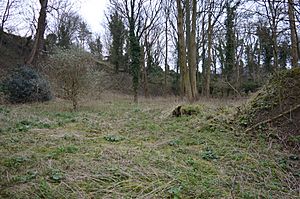South Lodge Pit facts for kids
| Site of Special Scientific Interest | |
 |
|
| Area of Search | Buckinghamshire |
|---|---|
| Interest | Geological |
| Area | 0.5 hectares |
| Notification | 1986 |
| Location map | Magic Map |
South Lodge Pit is a special place in Taplow, Buckinghamshire. It is a 0.5 hectare (about 1.2 acres) site. This means it is roughly the size of half a football field.
It is known as a Site of Special Scientific Interest (SSSI). This is a protected area in the UK. It helps to keep important wildlife, plants, or geological features safe. South Lodge Pit is special because of its geology. It is also a Geological Conservation Review (GCR) site. GCR sites are the best places in Britain to see important rocks and landforms.
Contents
What is South Lodge Pit?
South Lodge Pit used to be a chalk quarry. A quarry is a place where people dig out rocks or minerals from the ground. In this case, they dug out chalk. This chalk formed a very long time ago.
How Old is South Lodge Pit?
The rocks at South Lodge Pit are from the late Cretaceous period. This was about 83 million years ago. Imagine how old that is! The Cretaceous period was a time when dinosaurs still roamed the Earth.
A Unique Discovery
South Lodge Pit is very special. It is the only place in Britain where you can find a chalk phosphorite deposit. Phosphorite is a type of rock that is rich in phosphorus. Phosphorus is an important element. It is used in things like fertilizers.
This type of deposit is rare. It is similar to deposits found in the Paris Basin. The Paris Basin is a large area in France. Finding it here helps scientists understand how these deposits formed.
Ancient Seas and Fossils
During the late Cretaceous period, sea levels were much higher. Most of England, including Buckinghamshire, was covered by a warm, shallow sea. This ancient sea was full of life.
Scientists have found many marine fossils at South Lodge Pit. These fossils are like clues from the past. They tell us about the creatures that lived in that ancient sea. The fossils are found in different layers of rock, called horizons.
Some of the fossils found include:
- Annelids: These are a type of segmented worm.
- Oysters: These are a type of shellfish with two shells.
- Bivalves: This is a group of shellfish that includes oysters and clams. They also have two shells.
These fossils help scientists learn about the environment 83 million years ago. They show what the sea was like and what animals lived there.
Visiting South Lodge Pit
South Lodge Pit is on private land. This means that it is not open to the public. There is no public access to the site. It is important to respect private property.

